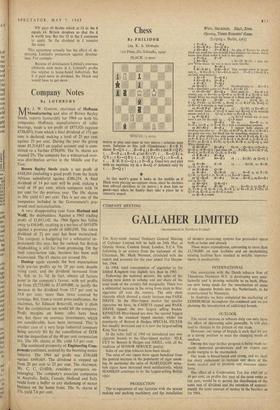Chess
By PHILIlDOR 229. K. S. HOWARD (1st Prize, Die Schwalbe, 2929) BLACK (9 men)
WHITE awn
WHITE to play and matt in two moves ; solution next week. Solution to No. 228 (Gooderson) R x B P, threat B—Q 6. R—B 4; 2 B—Kt 2 (set R x Q P). B—B 4; 2 R—K 4 (set Kt x P). R—Q Kt 2, Q B 3 ; 2 Kt —Q B 6. • R (Q B 2)—Q ; 2 R—K 4. . . . R (K B 2)—Q 2 ; 2 P—B 4. Good key and play with an excellent try in t R—Q z? defeated only by
t B—Q 5 !
In this week's game it looks in the middle as if Black were playing no-capture chess, since he declines four offered sacrifices in six moves ; it does him no good—and when he finally does take a piece he is instantly mated.
White, NEUKIRCH. Black,ZINN. Opening, THREE Kisnorrrs' GATAE. (Leipzig v. Berlin, 1965)
1 P—K 4 P—K • 2 Kt —K B 3 Kt—Q B
3 Kt—B 3 K[ 3 An idea of Keres's by which Black can avoid the very drawiah Four Knights v4r:Ations; this is better than Black makes it look in this game.
4 P—Q 4 P x P
White 5 • • • 4 Kt x P, B—Kt 2 does not
give White much: the text is much more forceful.
B—Kt
K's r Q Kt—K 2! This strange move is neces- sary. 6 .. K Kt—"K 2; 7 Kt—B 6 eh and 6 ... P-133; 7 B—K 134 are both unstnisfactory.
7 KtxP P—QB3
8 Kt—Q B 3 Q—P—QR 4
13—K 3 4
ro9 Q--Q 2 P x PP He should play z o Kt—B 3
with a reasonable game P—K 5, Kt—Kt 51).
rr 0-0-0! Kt—Q 4 Here again TO ... Kt—B 3 is correct, e.g. Kt—Kt 3 Q-13 2; 12 B—K B 4, Q—Q 2, and though White has much the better of it Black can stillplay. 12 Kt x Kt Q x Kt Or 12 . Q X Q chL 13 R x Q, P x Kt;. 14 Kt—Kt 5, K—Q r; 15 x P ch, D—Q 2; i6 Kt—Q 6 winning at least a pawn. , • B—Q B 4! Q—K 4 i3 . . . Q x IP; 14 Kt—Kt 5I with double threat of Q—Q 8 mate andKt—Q 6 ch winning queen—and if 14 • • • Q—Q 4; then 15 Kt—B 7 ch. 14 P-9 B3 . ..14 Kt X P would win at once i were t not or the reply 14Q x12 mate! . Q—K 2 Or t4 . . . Kt—K 2; 15 B-13 4. Q—R 4; t6 B—K Kt 5 with a tremendous position. 13 Kt—Kt B—K 4 I suspect both players of thinking that after t5 P x Kt; z6 B xP ch, K—B 1; 17 D—D 5 the game was over, but Black has the surprising resource 17 ... B—R 31 after which best play seems to be r8 13 x Q ch, K xli; 19 P—K BP x c.p.L2o K R—K z ch, B—K 3; 21 R—K 3!; P x PI; 22 K-8 2, B X R; 33 Q x B, R—B 1; Q—Q 4, and White should win. r6 11-8 3! Q—B 3 Or 16 ... Q—Q 2; 17 Q—K 3, Q—I1 4; t8 B—Q 6 I and wins (18 . P x Kt; 19 B X Kt P ch, B—Q 2; 2oBxB ch, Qx8; 21 BxB).
r7 K R—K 11-14_4
• R x P! Kt—Ka t8.,.Bx131; 19 Q—Q 7 mate. • x Kt Kxf 19 . . QxB; 20 RXB, QxR; 21 R—K 1. 20 Rx. 1 3 ch QxR al R—K z Qx R ch 21 B—K 5; 22 R x13, Q x R; 23(k-Q 6 ch, K—K I; 24 Kt—B 7 mate. 22 Q x ch K-13 3 Or 21 ...B—K 3; 23 Kt—B and 24 Kt x
a 23 Kt—Q *6 Q R—Q z
4 P-11 4! RxKt 24 K—Kt 2; 23 Ck—K s ch, P-13 3_; 26 Q—K ch, K—R 3; 27 Kt x B ch, P x t; 28 Q x P ch, K—R 4; 29 B—K 2 mate. as Q—K S ?nate


































 Previous page
Previous page